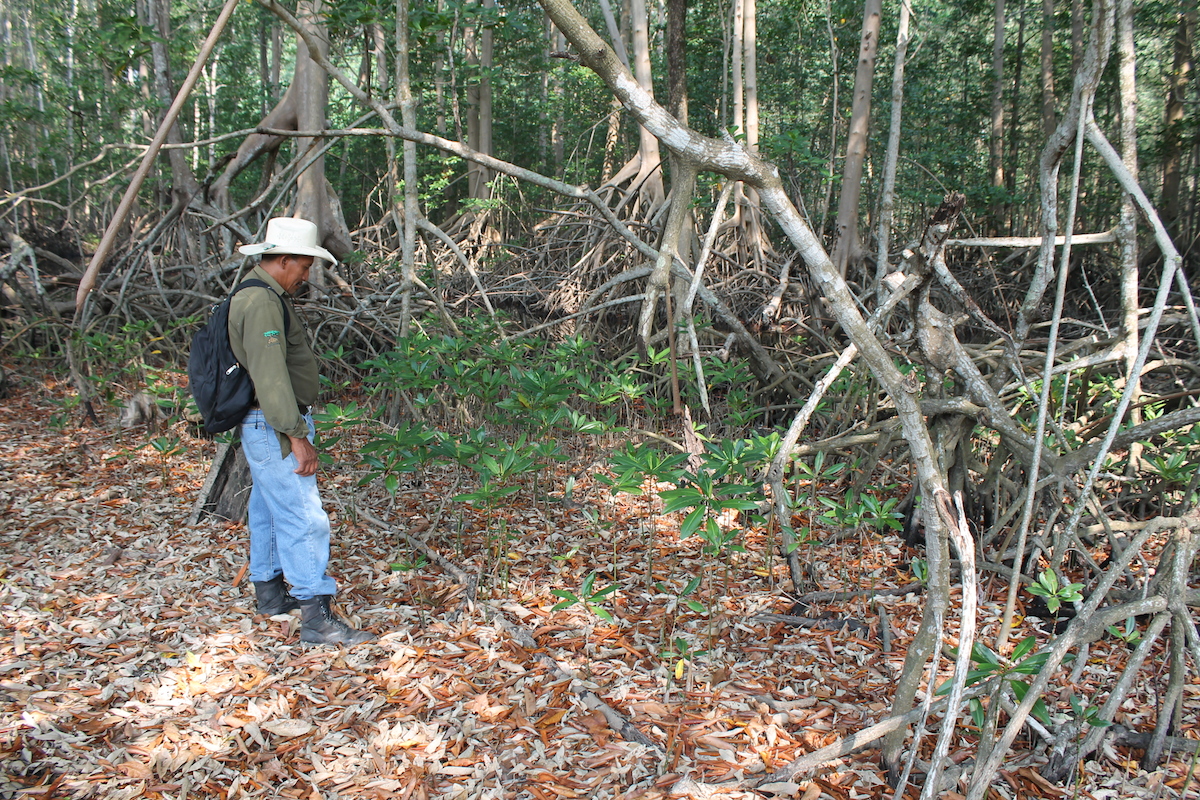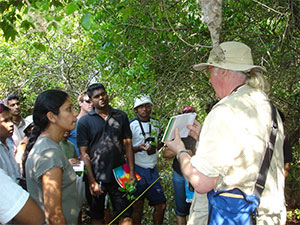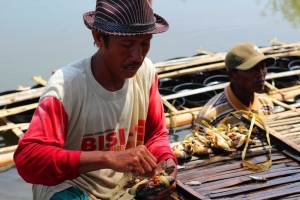Communities band together to protect El Salvador’s last mangroves

EL SALVADORE - “Without the mangroves, we couldn’t live here,” says José Antonio Hernández. “We wouldn’t have any water.” He is standing on a rare dry patch of soil amid a mangrove forest on El Salvador’s eastern coast. While his green button-up shirt bears the logo of the Ministry of Natural Resources (MARN), Juan works as a volunteer on his daily patrols of the mangroves. José Horacio Soriano accompanies Hernández on the patrol. They both work as Natural Resource Guards for the Mangrove Association, a coalition of 80 communities that protects the mangroves of Usulután province. The Lempa river divides Usulután from the neighboring province of San Vicente. The communities at the river’s southern end where it empties into the Pacific Ocean are known as the Bajo Lempa – or Lower Lempa. Hernández explains that he arrived in the Bajo Lempa at the end of El Salvador’s Civil War. In the 1992 Peace Accords, the government committed to redistributing land to the guerrillas of the Farabundo Martí National Liberation Front (FMLN) and members of the National Guard and Army.
READ MORE
AFRICA
South Africa joins the world in observing the International Day for Biological Diversity

SOUTH AFRICA - The theme of this year’s International Day for Biological Diversity is “Biodiversity and Sustainable Tourism”, and was chosen to coincide with the observance of 2017 as the International Year of Sustainable Tourism for Development, as proclaimed by the United Nations General Assembly (UNGA). The Convention on Biological Diversity defines IDB as the variability among living organisms from all sources including, terrestrial, marine and other aquatic ecosystems and the ecological complexes of which they are part. The minister of environmental affairs, Dr Edna Molewa said in a statement this year’s theme had particular resonance at a time when eco-tourism was growing in popularity and making greater contributions to South Africa’s economic growth. “Nature-based tourism, or rather eco-tourism is recognised as a driver and critical component to the sustainability and efficacy of conservation management,” said Molewa.
READ MORE
ASIA
Speakers stress importance of mangrove forests for coastal areas

PAKISTAN - Experts underlined the importance of combined efforts to protect Mangrove forests of Indus delta. They said that Mangrove forests, on the Pakistani coastal line, acted as a protection wall against Tsunami or cyclones. Mangrove forest is one of the most important factors that keep the coasts safe from sea water. They added that during the last few years, two million mangrove samplings had been planted along the Pakistani coasts. Pakistan owns one of the largest mangroves forests in the world, they informed. Country Representative IUCN Pakistan Mahmood Akhtar Cheema, National Coordinator Mangroves for the Future Programme (MFF) Pakistan Ghulam Qadir Shah, Director International Center for Chemical and Biological Sciences (ICCBS), University of Karachi (UoK) Professor Dr M Iqbal Choudhary, Dr Naeem Shahzad of NUST, and Amjad Siddiqui delivered lectures at the one-day workshop entitled, “Ecosystem Based Disaster Risk Reduction and Climate Change Adaptation for Integrated Coastal Zone Management,” held here at the Professor Dr Salimuzzaman Siddiqui Auditorium, ICCBS on Thursday. Mahmood Akhtar Cheema said that the country could witness a positive change only “If we start working together.”
READ MORE
Mangrove sites can mean serious business

INDONESIA - A rehabilitated mangrove site in Indonesia would have generated an estimated net worth of more than $15,000 in carbon revenue if developed as a carbon project, according to a Charles Darwin University PhD candidate. Clint Cameron forecasted that a 14-hectare site in Tiwoho, Sulawesi, would have generated thousands of dollars in carbon revenue over the 10 years since its mangroves were rehabilitated. “The deforestation of mangrove ecosystems and their conversion for other land uses is a big environmental issue in South-east Asia,” Mr Cameron said. “These findings show the tangible difference that mangroves could make to benefiting rural livelihoods, and will help build a picture of the potential emissions reduction profile from rehabilitating mangrove sites.”
READ MORE
Shrimp farming is booming in Tamil Nadu – but it is causing water and soil pollution

INDIA - It was nearly dusk in Killai village in coastal Cuddalore district, Tamil Nadu, on a warm summer day. In a barren field lined with coconut trees and date palm, a pair of loudspeakers tied to an electric pole blared Tamil folk music. In a slow procession, men and women of all ages trickled into the empty field where a stage was set, bearing a red banner with the words “Iraal Pannaigal Edhurpu Manadu”. A meeting to oppose shrimp farming. The villagers were residents of 15 villages around Killai who complained that shrimp aquaculture had turned their groundwater salty over the last 15 years and rendered all their drinking water sources unusable. The soil in these villages has turned so saline that groundnut and paddy, once harvested in plenty, no longer grow. The natural water holes, or oothu, from where they drew sweet potable water are now simply salt water springs. Making matters worse, the lush Pichavaram mangrove forests that garland the backwaters near Killai – a popular tourist attraction – are dying a slow death as a result of chemical waste from the shrimp farms.
READ MORE
Vietnam’s response to climate change? A shrimp and mangrove cocktail

VIET NAM - Like other shrimp farmers here in this lush, canal-lined province in Vietnam’s Mekong Delta, Nguyen Van A can instantly rattle off the precise percentage of saltwater in which crustaceans grow best. And at the moment, he insists with a smile, everybody knows that Ben Tre Province has the best brackish water in the world. “Shrimp and crabs in Ben Tre are always better than shrimp and crabs elsewhere, because the saltwater percentage is the best, so the meat tastes better,” he said. But Nguyen Van A also knows the percentage at which they begin to die. Last year, when the delta was devastated by the worst drought in recorded history, the amount of salt in Ben Tre’s water hit that target, and kept shooting up. The province's rice crops were the first to die, followed by hardier fruit trees and coconut palms. But eventually, even his salt water shrimp were all lost.
The struggle to save Arakan’s mangroves

MYANMAR - Until fairly recently, the residents of Kan Ngu, a coastal village in southern Arakan State, considered the mangroves in their area simply as another source of firewood and paid little attention to the shrinking forest. “The locals did not carry out mangrove conservation in the past and cut it down without permission,” recalled Kyaw Win, a 62-year-old former fisherman and village leader. But then, a few years ago, international aid groups begun to implement community projects that raised awareness of the mangroves’ important role in protecting the coastal environment and local attitudes quickly changed, he said. “The locals now understand the impacts of mangrove deforestation and they no longer destroy the forest,” Kyaw Win said. “These mangrove forests are our benefactor, they are the habitat of fish, prawns and crabs. And we can earn money from catching these animals.” He added the he and other villagers had set up a local committee to conserve the mangrove ecosystem. Mangroves are not only an important habitat, but also help protect the coastal environment against land erosion and floods caused by storms and occasional cyclones that lash the Arakan coast during rainy season.
READ MORE
Mangroves Under Threat From BMC; Trouble in Shiv Sena

INDIA - It is not just the builder mafia that mangroves in Mumbai are facing a threat from. Mangroves in Juhu and Versova are under dire threat from the civic body itself, thanks to carelessness and oversight in creating the revised draft Development Plan (DP) 2034. In the planning committee’s report submitted recently to the BMC, three plots of lands in Versova and Juhu have been opened up for development in the draft DP, despite the plots being part of mangrove land. The presence of mangrove land can be clearly seen in Google Earth visuals and has been verified through site inspections by elected representatives. What’s even more alarming for residents is that there is intentional setting of fire on the said mangrove land every 10 days to destroy them. Fire has been reported six times in the last two months in this area.
READ MORE
UWCT students lead new Marine Animal and Nature Trust Association

THAILAND - The Marine Animal and Nature Trust Association (Manta) is a student led co-curricular activity reflective of the United World College Thailand’s (UWCT) focus and engagement in Marine Conservation. The mangrove restoration part of Manta originally consisted of Alessandro in Grade 10, supervisor Kru (“Teacher”) Jalal, and myself (Jakub Bystricky). I had no experience with mangroves except for the planting trip we did during the orientation week at the beginning of Grade 11. Luckily, Kru Jalal showed us and helped us understand how the mangrove ecosystem functions. Afterwards, we explained the importance of mangrove forests through some presentations to other students at UWCT. Once Kru Jalal said, “I’ve led several planting trips where our community has planted over 4,000 mangroves since I arrived at UWCT and my dream is to have a mangrove nursery here on site.” And I have to say that Alessandro and I liked that dream too. So we had a plan. As we needed money, we decided to use a “Global Concerns Fund” (GC). We went through the long process of becoming a GC and finally got our project approved. However, we didn’t become a GC alone. Coincidentally, another group with similar interests was also trying to be a GC club and they also didn’t have enough members.
READ MORE
AMERICAS
Call to stop mangrove clearing
MEXICO - In Chicxulub Puerto, where there is invasion of the marsh and destruction of mangrove to build shacks, the First Mangrove Festival will be held from June 2 to 5, Genaro Pérez Figueroa, coordinator of the event, said Wednesday. The objective of the festival is to inform and generate awareness in the population about the importance that the mangrove has in the coastal ecosystem, he indicated. And at the same time to send a message to society and the authorities that in Chicxulub Puerto “we are not indifferent to this serious problem of invasion and destruction of wetlands and mangrove”, he said. The festival is organized by citizens who formed the group Caracol Project, Chicxulub Puerto, which in the future will constitute a civil association.
READ MORE (EN ESPANOL)
Forestry Dept to restore mangroves and swamps

JAMAICA - The Forestry Department will be carrying out a number of initiatives for the restoration of the island's mangroves and swamps as part of an expanded mandate to reforest significantly depleted areas.According to the department, following a land use assessment conducted between 1998 and 2013, it was found that the two forest types have been depleted by some 98 per cent. The report from this assessment, it said, formed the basis for the National Forest Management and Conservation Plan, which specifies line actions for the restoration of the forest types. Senior research officer at the Forestry Department, Brahim Diop told JIS News that, based on the report, it was determined that the department should lead a concerted national effort in this regard. “These two forest types are particularly important for climate change adaptation, so, we decided. and other stakeholders have seen the importance of the Forestry Department having management responsibility over mangroves and swamp forests found on government-owned lands,” he said.
READ MORE
Mangrove Action Project shares with WFI International Fellows

USA - Mangrove Action Project’s Sara Lavenhar was asked to present to a group of International Fellows at the World Forest Institute of Portland, Oregon. WFI’s team of International Fellows is selectively chosen from the forestry profession around the globe. In a program unique to the industry, these Fellows serve six month Fellowships at WFI, using a wide range of skills, expertise and language abilities to complete a primary project. Fellows participate in the program through the U. S Department of State’s Visa Exchange Visitor Program. The purpose of the Exchange Visitor Program is to promote mutual understanding between the people of the United States and the people of other countries through educational and cultural exchanges. The WFI Fellows learn about sustainable forestry in Oregon and carry that knowledge forward globally, promoting best practices when they return home. They recently reported on the knowledge they gained.
READ MORE
LAST WORD
MAP's Letter of Concern to Mexican Government Officials:
To: Mr. Carlos Berlin Montero (SEMARNAT): carlos.berlin.montero@gmail.com,
Dr. Eduardo Adolfo Batllori Sampedro: eduardo.batllori@yucatan.gob.mx,
Biol. Ignacio Millán Tovar, (PROFEPA): imillan@profepa.gob.mx
Dear Sirs,
We at Mangrove Action Project have for 25 years been working to conserve and restore our planet’s mangrove ecosystems, which today are threatened by short-sighted development. MAP was founded as an international network back in 1992, but evolved into an active community-based organization working with local NGOs and communities in an effort to halt further mangrove loss. We were quite alarmed when we heard news about what was happening to the mangroves in Chicxulub Port, Yucatán, Méxicom where recent mass clearing of mangroves was occurring illegally in the area.
MAP has grown steadily during the last 24 years to become a respected member of the global environmental movement. MAP's international network has grown to include over 500 NGOs and 350 scientists and academics from over 60 nations. One of our primary goals is to raise awareness about the important services and benefits mangroves provide.
These unique and endangered ecosystems serve as nurseries and essential habitat for a myriad of marine life, vital for commercial fisheries and the livelihoods of millions of fishermen. Mangroves protect coral reefs and sea grass beds, are amazing carbon sequesterers and protect the shorelines from erosion and damage from wave action, tsunamis and hurricanes. With rising sea levels and increasing frequency and intensity of storms, mangrove valuations are skyrocketing.
Thus we now appeal to you to help stop the current mangrove destruction in the area of Chicxulub Port. Your help to halt this wasteful loss is essential. Please let us know if you need more information concerning the problems arising there, as we are happy to be of service in answering any questions you may have. I urge you to visit our website at: mangroveactionproject.org. I also am attaching a link to our Spanish section of our website for your review.
For the Mangroves,
Alfredo Quarto,
C0-director
Mangrove Action Project
360-462-5866



















